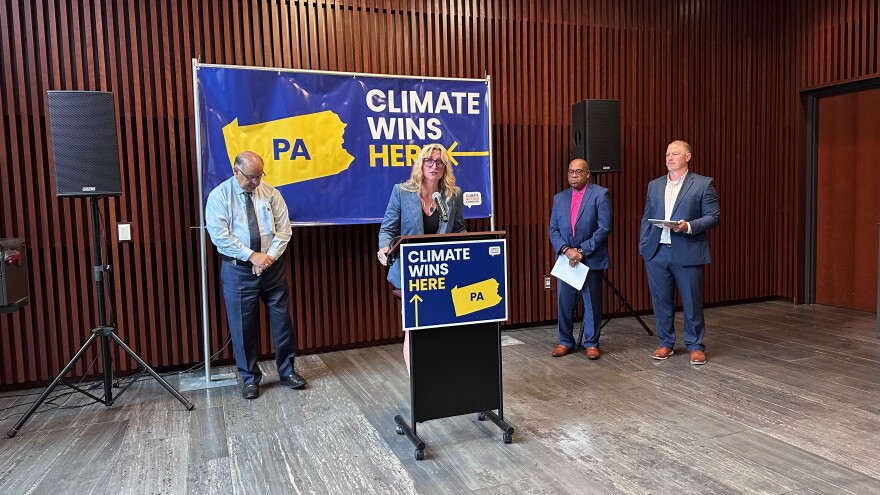EASTON, Pa. — Federal investments in energy efficiency and weatherization that aim to help local residents in the face of a changing climate could also help Easton reach its energy efficiency goals, officials said Thursday.
Easton Mayor Sal Panto Jr. and other officials met at city hall to talk about how the Inflation Reduction Act and the Bipartisan Infrastructure Law can be used to improve energy efficiency, lower energy cost and transition to a greener future.
On a local level, residents will see tangible impact with the expansion of the low-income Weatherization Assistance Program, which can go a long way toward helping those in move toward energy efficiency, they said.
“It's an issue of environmental justice and equity. By supporting weatherization for local low-income families, we prevent them from choosing between home upgrades and the essentials like food or utility bills or housing."Northampton County Controller Tara Zrinski
Panto stressed the importance of America’s mayors “leading the charge” when it comes to fighting climate change.
He said policies, programs and zoning initiatives are “building climate resiliency, promoting the use of clean energy and reducing greenhouse gas emissions in cities across the country.”
To that end, he said the city needs to swiftly enact its Climate Action Strategy.
Local governments can't do it alone
The Climate Action Strategy plan, launched in October 2021, includes goals to, by 2030, cut the city’s greenhouse gas emissions 50% from 2019 levels, with a goal of reaching net zero emissions by 2050.
But Panto said local governments can't accomplish everything on their own.
So the Inflation Reduction Act, signed by President Joe Biden in 2022, provided hundreds of billions of dollars in commitments to reshaping energy use and reducing emissions.
“Preservation of our environment is not a liberal or conservative challenge, it’s common sense.”Easton Mayor Sal Panto Jr., quoting President Ronald Reagan
“These commitments include tax credits and rebates for solar panels, electric vehicles and heat pumps,” Panto said.
“Many groups committed to electrification and fighting climate change heralded the legislation’s environmental initiatives. Rewiring America called it a ‘landmark climate investment to charge a path forward.'”
To make change, Panto said, the most important thing to do is “implement this plan and not let it sit on the shelf.”
City workers have planted thousands of trees throughout the metropolitan area, officials open fire hydrants for residents to cool off on hot days and, nearly 15 years ago, Easton passed a Solar Energy Ordinance.
Panto also pointed out the city has updated building codes to include energy efficiency elements. Furthermore, the police department purchased the city’s first electric van.
Electric charging stations are being installed in the local parking garages, and bike exchange programs also are being explored.
“Our biggest energy conservation is down to wastewater treatment plant, where we produce methane gas from the solids," Panto said.
"And methane gas is being converted to energy, which will not only save taxpayers money, but also help clean the environment, because we will actually provide enough energy to electrify the entire plant.”
Panto quoted President Ronald Reagan: “Preservation of our environment is not a liberal or conservative challenge, it’s common sense.”
Weatherization for low-income
Northampton County Controller Tara Zrinski said residential energy use contributed about 20% to the total levels of greenhouse gas emissions.
She said it's necessary to follow measures such as the Paris Agreement or face increasing risks associated with climate issues.
Upgrading buildings could cut those figures in half by 2050, she said, but weatherization for homeowners needs to be explored now.
“This is why funding from the Infrastructure Investment and Jobs Act and the input inflation Reduction Act are crucial," she said.
"These funds help reduce energy use, airborne pollutants and CO2 emissions, and weatherization improvements not only provide financial benefits, but also alleviate psychological distress.
“It's an issue of environmental justice and equity. By supporting weatherization for local low-income families, we prevent them from choosing between home upgrades and the essentials like food or utility bills or housing.”Northampton County Controller Tara Zrinski
“It's an issue of environmental justice and equity. By supporting weatherization for local low-income families, we prevent them from choosing between home upgrades and the essentials like food or utility bills or housing.”
Zrinski said weatherization might not sound “sexy or exciting,” but it is essential to mitigate the impact of climate change, and federal, state and local funding will prove integral to offering the services to everyone, especially those who are low-income.
Expanded assistance
Zrinski said about 280,000 homes in Pennsylvania show significant deficiencies that can be helped by weatherization, she said.
“Weatherization helps fight climate change, but it also protects families from extreme temperatures and reduces their energy use," she said.
"It also addresses health issues such as asthma or anxiety from inadequate home conditions. Many low-income households and renters face uncomfortable living conditions due to mold, drafty homes and outdated systems.
Energy insecurity disproportionately affects black and brown communities, single women with children and older adults on fixed incomes, she said.
According to Zrinski, the Infrastructure Investment and Jobs Act and the Inflation Reduction Act have set aside $1.8 million for the Lehigh Valley, with 17 homes in Northampton County already weatherized through the Weatherization Assistance Program.
“The average cost per home was $8,200, and while funding is essential, we also face challenges like training, workforce development and addressing pre-existing home issues like fixing a roof or structural damages,” Zrinski said.
Easton Vice Mayor Ken Brown commended the president and his staff for their work on the clean energy plan and the impact it has on a local level.
“We can see how the weather has changed over the last couple of decades, with more and more hurricanes, tornados and earthquakes right here in our own backyard," he said.
"Through the Clean Energy Plan climate investment, we're lowering energy costs for Pennsylvania families by an average of $372 a year.
"Pennsylvanians benefit from a $3.5 billion national investment and energy efficiency. It makes a difference, and it will make a difference here to our Easton families."
'Inefficient home an expensive home'
Director of the Center for Residential Reinvestment Programs Nick Horting provided further insight into how the state Community & Economic Development Department provides $20 million a year in grants through the Weatherization Assistance Program, benefiting around 1,500 homes.
“It's no secret that an inefficient home is an expensive home."Nick Horting, Director of the Center for Residential Reinvestment Programs
“It's no secret that an inefficient home is an expensive home," Horting said. "So weatherization aims at protecting the home from the outside elements like moisture and cold air in the winter and hot air in the summer.
"We do this by utilizing the latest in building science technologies to analyze and then properly seal and ventilate the home."
The average cost to weatherize a Pennsylvania home was $8,250 in 2021, Horting said. Thanks to the Infrastructure Investment and Jobs Act, the state’s weatherization programs have been able to allocate $186 million more to the mission.
“Statewide, it's estimated that this single investment will allow for over 14,000 homes to be weatherized over the next five-plus years," he said.
Despite success so far, there is still a long way to go, Horting said.
The state has taken in about $93 million of the funding, “and it’s a priority of our office to make these crucial investments as soon as possible” before the cash is reallocated, he said.


